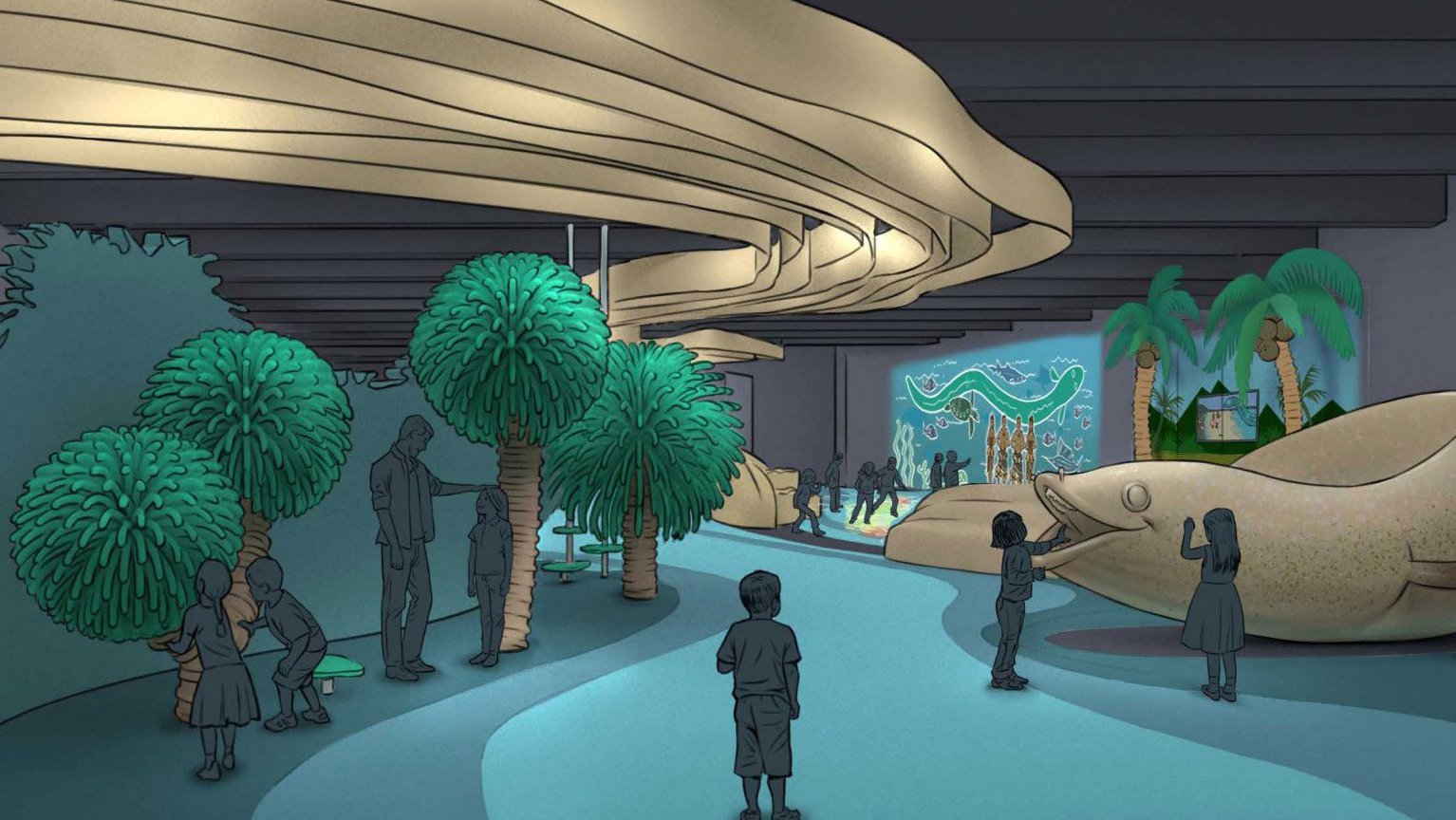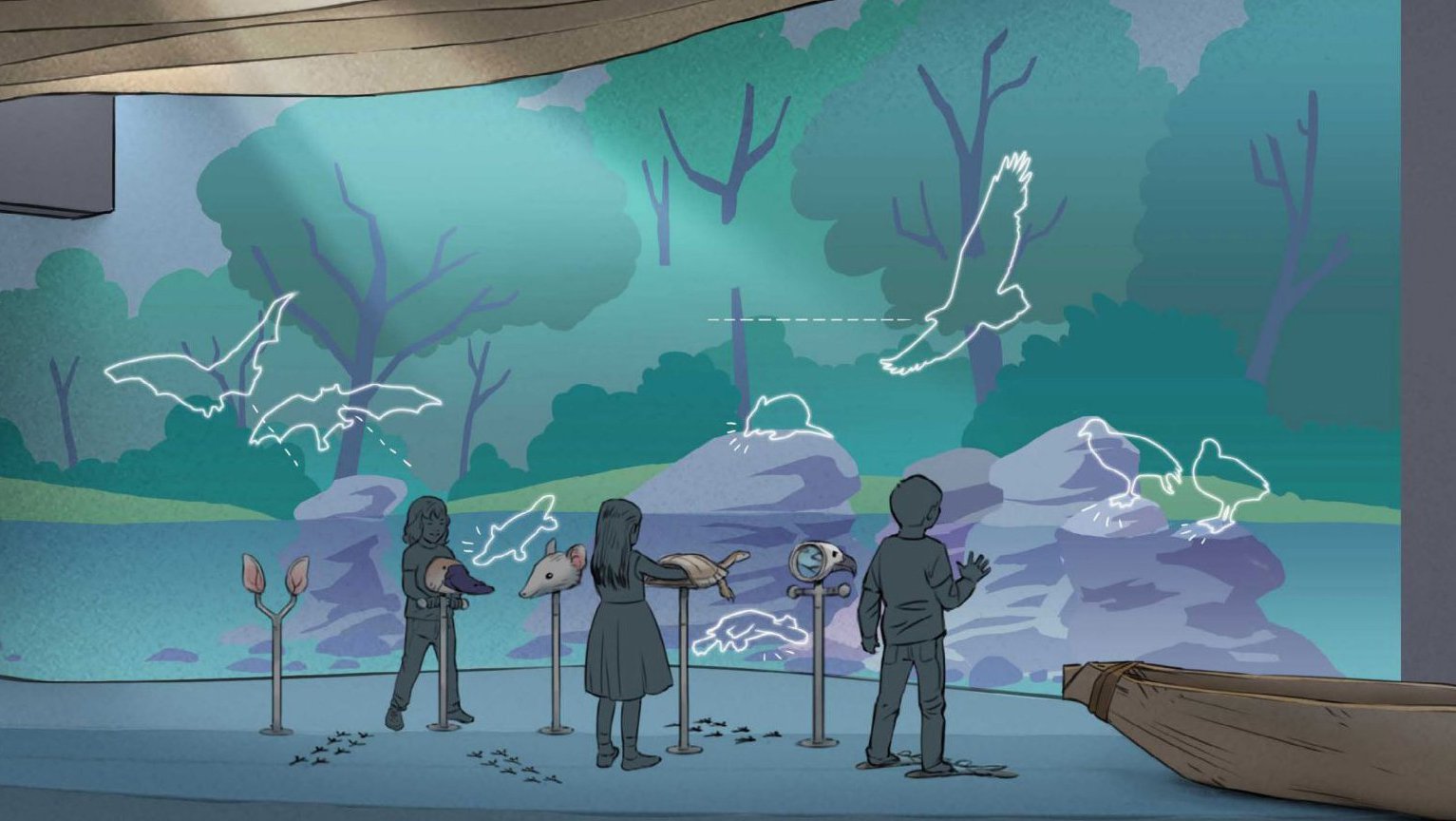Australian Museum opens Burra: a ground-breaking, interactive learning and play space
Friday 1 July 2022, Sydney: The journey of the eel from the Pacific Ocean down the east Australian current to Sydney harbour is told in Burra, a new multi-million dollar permanent learning and play space at the Australian Museum (AM) combining First Nations and western science. Burra was officially opened today by NSW Minister for Aboriginal Affairs and the Arts The Hon. Ben Franklin MLC.
Burra, which means eel in the First Nations languages of Sydney and the South Coast, allows curious children aged 0-14 to follow the extraordinary life cycle of the eel across fresh, brackish and saltwater ecosystems. Along the way, children will learn about the environment and the importance of taking care of it through fun and interactive experiences – including a giant eel.
At the official opening for the space today, NSW Minister for the Arts Ben Franklin said the Burra is a great way for children and families across the state to experience culture and science.
“As a truly unique experience in the heart of Gadigal Country, Burra is an exciting new state-of-the-art gallery that immerses you in western science and Aboriginal knowledge. It’s fantastic to see the Australian Museum leading the way in this space – at the intersection of science and culture – and even better that Burra is accessible for everyone to enjoy with the extension of free general admission at the Australian Museum,” Minister Franklin said.
Located on level two of the AM covering 700sqm, Burra features two multi-purpose teaching spaces and several versatile programming areas, as well as a theatre where visitors will learn the Gundungurra cultural creation story of the Jenolan Caves in the Blue Mountains featuring Gurangatch (a giant eel-like creature) and Mirrigan (a large native marsupial). In Burra, visitors will also explore First Nations technologies, investigate dioramas of local flora and fauna like mangroves and rockpools, see a stone core dug from under the AM by the AMRI Geosciences team and experience a projection of the East Australian Current.
“First Nations knowledge is based on deep respect and relationships with nature. Learning about these intimate connections between First Nations Peoples and the environment, alongside western science, will help visitors gain a relatable experience of science and help build knowledge of local cultural wisdom. There’s never been a better time to open Burra, just in time for NAIDOC Week and the winter school holidays,” McKay said.
“This landmark education centre – made possible by generous support from the NSW Government and our partners and donors – challenges the traditional museum model by bringing together First Nations, Pacific and Western scientific and cultural knowledge systems in new and ground-breaking ways.
“It demonstrates how science and culture can actively support and enrich each other, while sharing the importance of caring for Country and looking after our environment,” McKay said.

© Australian Museum
Laura McBride, Wailwan and Kooma woman and Director, First Nations at the AM, said the eel is significant in many different First Nations cultures in the region.
“Burra’s journey teaches us about our local ecosystems and the impact humans have had upon the eel and other living beings. The Burra education space incorporates Indigenous values that can help us reframe how we think and interact with each other and our environment' Laura McBride
“I’d like to thank the many Aboriginal and Pasifika community members who shared their knowledge and stories for Burra. One of the highlights of the project was a workshop we held with Aboriginal Elders and youth, who created a Possum Skin Cloak featuring stories and knowledge of Country and culture that they wanted to teach to visitors at the Museum,” McBride said.
Professor Kristofer Helgen, Chief Scientist and Director, Australian Museum Research Institute said Burra will help children engage in critical thinking about the world around them.
“In Burra, visitors will learn about science including biodiversity, biology and geology as they follow Burra the Eel through different ecosystems, all while learning how First Nations Peoples have been caring for Country for thousands of generations,” Helgen said.
“The eel is the perfect main character for Burra because of its own epic journey and adaptation to its environments. Eels begin their lives in the Pacific and migrate to the coasts, estuaries and freshwater rivers of Australia where they spend decades inland maturing. These animals are both fascinating and mysterious – we still don’t know for sure exactly where they breed or lay their eggs, ” Helgen added.
The Burra team worked with First Nations communities to develop content for the exhibition, including wall murals by artist Jasmine Miikika Craciun, a Barkindji, Malyangapa, and Tongan woman. The artworks are directly informed by Country itself with inspiration taken from eel habitats between North Sydney, far south coast, and Burragorang Valley.
Burra opens FREE to the public on Saturday 2 July. A special program of activities will celebrate the opening weekend of Burra as part of NAIDOC Week and the winter school holidays, including weaving and language workshops with Elders and community members who contributed to Burra.
The Burra build is supported by the NSW Government as part of the Australian Museum's major transformation, Project Discover. Burra is also funded by the Australian Museum Foundation through an extraordinary bequest from the estate of the late Patricia McDonald a former AM Educator. Patricia believed in a hands-on approach to children’s discovery of the natural world and was a pioneer of AM education. The programming and education in Burra space made possible thanks to the support of generous donors and partners including Wollemi Capital Group, Charles Warman Foundation, Vanessa Tay and Alex Ding, IAS Fine Art Logistics, WPP and Westpac.
Download the Media Release and fact sheet
About the Australian Museum
The Australian Museum (AM) was founded in 1827 and is the nation’s first museum. It is internationally recognised as a natural science and culture institution focused on Australia and the Pacific. The AM’s mission is to ignite wonder, inspire debate and drive change. The AM’s vision is to be a leading voice for the richness of life, the Earth and culture in Australia and the Pacific. The AM commits to transforming the conversation around climate change, the environment and wildlife conservation; to being a strong advocate for First Nations cultures; and to continuing to develop world-leading science, collections, exhibitions and education programs. With 22 million objects and specimens and the Australian Museum Research Institute (AMRI), the AM is not only a dynamic source of reliable scientific information on some of the most pressing environmental and social challenges facing our region, but also an important site of cultural exchange and learning.
Media Contacts
Farley Fitzgerald, Head of Communications
T 0455 306 788
E farley.fitzgerald@australian.museum
Claire Vince, Media and Communications Adviser
T 0468 726 910





